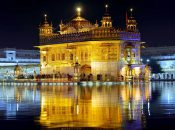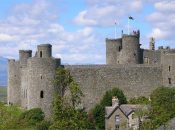The Hassan II Mosque, located in Casablanca, Morocco, is one of the most impressive architectural marvels in the Islamic world. Completed in 1993, the mosque stands as a symbol of Morocco’s rich cultural heritage and Islamic traditions. It was commissioned by King Hassan II to commemorate his 60th birthday and to showcase the country’s devotion to Islam.
The mosque’s design is a blend of traditional Moroccan architecture and modern engineering techniques. Its towering minaret, standing at 210 meters (689 feet), is the tallest minaret in the world and serves as a beacon for Muslims across the region. The mosque’s expansive prayer hall can accommodate up to 25,000 worshippers, making it one of the largest mosques in the world.
One of the most striking features of the Hassan II Mosque is its location overlooking the Atlantic Ocean. The mosque’s position on a promontory offers stunning panoramic views of the sea and the city of Casablanca. The mosque’s exterior is adorned with intricate tilework, marble, and granite, reflecting the craftsmanship and attention to detail that went into its construction.
Inside, the mosque is equally impressive, with a grand prayer hall adorned with ornate chandeliers, intricate carvings, and a massive retractable roof that allows natural light to filter in during the day. The mosque also houses a madrasa (Islamic school), a library, and a museum dedicated to Islamic art and history.
The Hassan II Mosque is not only a place of worship but also a symbol of Morocco’s commitment to modernity and progress. It attracts thousands of visitors from around the world each year, who come to admire its beauty, learn about its history, and experience the rich cultural heritage of Morocco firsthand.

Hassan II Mosque
To know more about the Hassan II Mosque, let’s take a look at these 33 interesting facts about Hassan II Mosque.
- Commissioned by King Hassan II: The Hassan II Mosque was commissioned by King Hassan II of Morocco to commemorate his 60th birthday and to showcase Morocco’s devotion to Islam.
- Location: Situated in Casablanca, Morocco, the mosque overlooks the Atlantic Ocean and is positioned on a promontory, offering stunning views of the sea and the city.
- Construction Duration: The construction of the Hassan II Mosque took six years to complete, from 1986 to 1993.
- Architectural Style: The mosque combines traditional Moroccan architecture with modern engineering techniques, creating a unique and striking design.
- Minaret Height: The mosque’s minaret stands at an impressive height of 210 meters (689 feet), making it the tallest minaret in the world.
- Capacity: The prayer hall of the Hassan II Mosque can accommodate up to 25,000 worshippers, making it one of the largest mosques in the world.
- Marble and Granite: The exterior of the mosque is adorned with intricate tilework, marble, and granite, showcasing the craftsmanship of Moroccan artisans.
- Grand Prayer Hall: Inside the mosque, the prayer hall is adorned with ornate chandeliers, intricate carvings, and a massive retractable roof that allows natural light to filter in.
- Ocean-View: The mosque’s location overlooking the Atlantic Ocean provides worshippers with a serene and picturesque backdrop for prayer.
- Madrasa and Library: In addition to the prayer hall, the mosque complex includes a madrasa (Islamic school) and a library.
- Museum: The Hassan II Mosque also houses a museum dedicated to Islamic art and history, showcasing artifacts and exhibits related to Morocco’s cultural heritage.
- Handcrafted Features: Many of the mosque’s features, including its mosaics, woodwork, and plasterwork, were handcrafted by skilled artisans using traditional techniques.
- Islamic Calligraphy: Islamic calligraphy adorns the walls of the mosque, featuring verses from the Quran and other religious texts.
- Large Plaza: The mosque complex includes a large plaza that can accommodate thousands of worshippers during special occasions and religious festivals.
- Multiple Entrances: The mosque has several entrances, each adorned with intricate arches and decorative motifs.
- Seawater Cooling System: The Hassan II Mosque is equipped with a seawater cooling system that regulates the temperature inside the prayer hall, providing a comfortable environment for worshippers.
- Architectural Innovation: The mosque’s design incorporates innovative engineering solutions, such as the retractable roof and the use of reinforced concrete, to withstand seismic activity and ocean winds.
- Symbol of Modernity: The Hassan II Mosque is considered a symbol of modernity and progress in Morocco, reflecting the country’s aspirations for development and advancement.
- Interfaith Dialogue: The mosque promotes interfaith dialogue and cultural exchange, welcoming visitors of all faiths to learn about Islam and Moroccan culture.
- Tourist Attraction: The Hassan II Mosque is a popular tourist attraction in Casablanca, drawing thousands of visitors from around the world each year.
- Guided Tours: Guided tours of the mosque are available for visitors, providing insights into its architecture, history, and significance.
- Night Illumination: The mosque is illuminated at night, creating a breathtaking spectacle that highlights its architectural beauty and grandeur.
- Annual Events: The mosque hosts various religious and cultural events throughout the year, including Eid celebrations, Quran recitations, and lectures.
- Environmental Sustainability: Efforts have been made to make the mosque more environmentally sustainable, such as using energy-efficient lighting and water-saving technologies.
- Community Outreach: The mosque is actively involved in community outreach programs, providing educational and social services to local residents.
- International Recognition: The Hassan II Mosque has received international recognition for its architectural significance and cultural importance.
- Film and Media: The mosque has been featured in numerous films, documentaries, and television programs, showcasing its beauty and historical significance to a global audience.
- Religious Symbolism: The mosque’s design incorporates various religious symbols and motifs, reflecting the rich spiritual heritage of Islam.
- Architectural Awards: The Hassan II Mosque has won several architectural awards for its innovative design and cultural significance.
- Pilgrimage Site: The mosque is considered a pilgrimage site for Muslims, who visit to pray and seek spiritual enlightenment.
- Modern Amenities: Despite its traditional design, the mosque is equipped with modern amenities, including Wi-Fi access and audiovisual equipment for religious lectures and presentations.
- Local Artisans: Local artisans and craftsmen were employed in the construction of the mosque, preserving traditional Moroccan craftsmanship and supporting the local economy.
- Legacy: The Hassan II Mosque stands as a testament to Morocco’s cultural heritage, religious devotion, and architectural ingenuity, leaving a lasting legacy for future generations to admire and appreciate.
The Hassan II Mosque stands as a magnificent testament to Morocco’s rich cultural heritage, architectural prowess, and religious devotion. Its towering minaret, breathtaking oceanfront location, and intricate design elements make it a symbol of national pride and a beacon of Islamic architecture. Beyond its physical beauty, the mosque serves as a center for spiritual contemplation, community engagement, and interfaith dialogue, welcoming visitors from around the world to experience its grandeur and significance. As a lasting legacy of King Hassan II’s vision and Morocco’s commitment to modernity and tradition, the Hassan II Mosque continues to inspire awe and reverence, leaving an indelible mark on all who have the privilege of witnessing its splendor.





